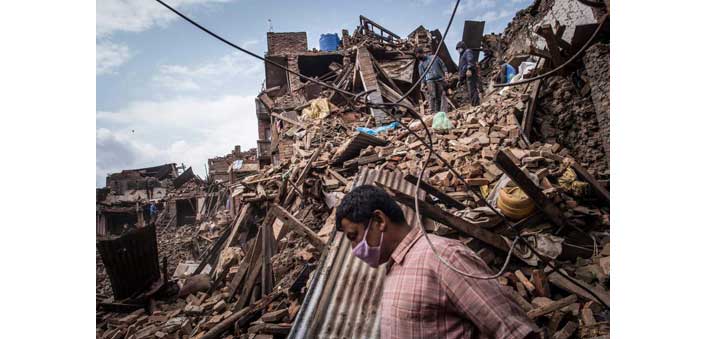Circa 2015 – Jammu and Kashmir floods in March 2015 seven months after the previous floosd on the Jhelum River.
Circa 2014 (October) – Annapurna Summit trekkers impacted by a severe storm and avalanche; 43 killed and 175 injured; April, 2014 – Avalanche strikes the Everest Summiteers killing mostly 16 Sherpas (mountain Guides); September 2014 – Jammu & Kashmir faces floods due to excessive rains triggering water logging, landslides, avalanches in the region, submerging 390 villages and bringing Srinagar under 12 feet water; Landslide in June and July in Chamoli and Guwahati; May 2014 – Kanchenzonga Peak avalanche, killing three.
How green was this valley
Welcome to the world of the Himalayas, the auspicious, impenetrable abode of snow, flanking India as a guardian in the North. These lonely, stately hills are a favourite of the humans and the gods and perhaps its mysticism has been locked in the innumerable stories of lamas, sherpas, Yeti, Hindu gods, sages, tantrics and demons. It has a unique draw for trekkers and people seeking higher forms of learning. The majestic hills have been home to species unknown to the world and are India’s biodiversity hotspot. Multiple rivers originate from these snow capped ranges: Ganga, Yamuna, Brahmaputra, Indus, Zanskar, Sutlej, Kali, Kosi, Teesta among many others which descend with their load of water and silt on to the plains bringing in their wake prosperity and agricultural bounty. Home to some of the loftiest peaks and glacier entrenched valleys, the Himalayas have attracted tourists over the years. Sporadically, there are economic activities such as cultivation along the mountain sides for rice, orchards for apples and oranges, plantations for tea and apricot, handicrafts predominating in coniferous woods, wool, and lac, silver and mining along the slopes.
The degradation
It is indeed a world of fantasy and charm one rarely finds in the common world. A geographical region attached to India yet so definitively different in nature and regimes. A region so alluring that it has attracted development and degradation almost in the same breath. The mountain states in India – Jammu & Kashmir, Himachal Pradesh, Uttarakhand, Sikkim, West Bengal, Assam and Arunachal Pradesh – have all taken to development rampantly, regardless of the limits to the natural threshold.
Some of our states are border states and have the unique need of implacable infrastructure to protect the country at all times. Another problem in the region is the development of hydro electric projects to harness the mountain streams and distribute power. It is not that development is undesirable, but unplanned and unsustainable development is hardly desired. The Himalayan states have the urgent need to develop like the rest of India and have adequate infrastructure to encourage distribution of goods and services and have ample facilities such as health, connectivity, financial set up and resource base. Increased mobility of tourists has swung the graph of tourist visits to the Himalayan states only upwards, thereby placing greater stress on the mountain ecosystems.
The carrying capacity of the hill states is critical and may have reached a tipping point as has been witnessed in the recent surge of environmental disasters in the region. Over the past few years, the number of natural disasters has been on the rise in the Himalayas with almost three to four such occurrences in a year. The number of people impacted by the disasters has been rising too, as many more people have begun to live on the hills as also the number of tourists which has increased dramatically. Back in older times, the nature of the disasters were dominantly earthquake and landslides, and since the number of people living in the avalanche prone areas were very few, it never featured as a major disaster. Today, all disasters have become complex having multiple incarnations, so an earthquake can trigger landslides, dam bursts, avalanches and the people impacted have risen significantly. There is also a marked increase in the climatological disasters like cloud burst (flash floods) and floods in the Himalayas, (Kashmir, Leh, Uttarakhand), making the region vulnerable even in the seasons which were otherwise expected to be a safe time to travel into the hills.
Are we on the right path to ensure that the hills are protected? Have we as a race forgotten the need for these hills for our survival, or are we deliberately choosing to ignore nature`s warnings? It would not be long that unplanned urbanisation, rampant Floods in Kashmir have become a regular occurrence tourism development, building of dams and tunnels, mining and population pressure will choke the mysticism these hills have given to Indians/Asians. Would it take so much as a fraternity to ensure that we harness these hills more responsibly?
There is no better way to end my concern as an environmentalist but to state a small story of the hermit in 1992. While I was on a trek on the Kedarnath hills, a hermit calmly sitting in a rocky interior of a cave smiled at me and said, “Dekh lo beta, aaj hai, kal shayad na rahe” (See it my child, all this may not be there tomorrow) and he summed up what every environmentalist would like to say; spare the hills or else there would be none at all. In simple terms, live with nature or it will retaliate in a manner which will obliterate our entire race.


